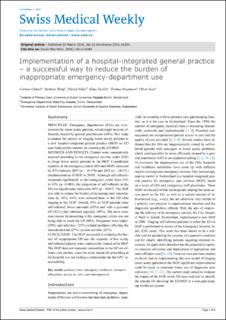Bitte benutzen Sie diese Kennung, um auf die Ressource zu verweisen:
https://doi.org/10.21256/zhaw-3137| Publikationstyp: | Beitrag in wissenschaftlicher Zeitschrift |
| Art der Begutachtung: | Peer review (Publikation) |
| Titel: | Implementation of a hospital-integrated general practice : a successful way to reduce the burden of inappropriate emergency-department use |
| Autor/-in: | Chmiel, Corinne Wang, Mathyas Sidler, Patrick Eichler, Klaus Rosemann, Thomas Senn, Oliver |
| et. al: | No |
| DOI: | 10.21256/zhaw-3137 10.4414/smw.2016.14284 |
| Erschienen in: | Swiss Medical Weekly |
| Band(Heft): | 146 |
| Heft: | w14284 |
| Seite(n): | 1 |
| Seiten bis: | 9 |
| Erscheinungsdatum: | 10-Mär-2016 |
| Verlag / Hrsg. Institution: | EMH Schweizerischer Ärzteverlag |
| ISSN: | 1424-7860 1424-3997 |
| Sprache: | Englisch |
| Schlagwörter: | Access to care; Care management; Emergency medicine; Resource allocation; Primary care |
| Fachgebiet (DDC): | 362.11: Krankenhäuser und verwandte Einrichtungen |
| Zusammenfassung: | Principles: Emergency departments (Eds) are over-crowded by lower acuity patients, which might be more efficiently treated by general practitioners (Gps). This study evaluated the impact of triaging lower acuity patients to a new hospital-integrated general practice (HGP) on ED case-load and the reasons for choosing the ED/HGP. Methods and Results: Patients were consecutively assessed according to the emergency severity index (ESI) to triage lower acuity patients to the HGP. Consultation numbers at the emergency centre (Ed and HGP) increased by 43% between 2007 (n=16974) and 2011 (n=24331) (implementation of HGP in 2009). Although self-referrals increased significantly at the emergency centre from 54% to 63% (p<0.001), the proportion of self-referrals at the ED was significantly reduced to 48% (p=0.007). The HGP was able to reduce the burden of increasing total consultations by 36%; 4.6% were referred back to the ED after triaging to the HGP. Overall, 95% of HGP patients were self-referred, Swiss nationals (65%) and with a personal GP (82%) they attended regularly (69%). The most common reason for presenting at the emergency centre was not being able to reach the GP(60%). Diagnoses were injury- (29%) and infection- (23%) related problems affecting the musculoskeletal (27%) system and skin (21%). Conclusion: The HGP succeeded in reducing the burden of inappropriate ED use: the majority of low acuity self-referred patients were conclusively treated at the HGP. The HGP does not represent competition to the GP out-of-hours care service, since the main reason for presenting at the hospital was not lacking a relationship but the Gps’in-accessibility. |
| URI: | https://digitalcollection.zhaw.ch/handle/11475/17751 |
| Volltext Version: | Publizierte Version |
| Lizenz (gemäss Verlagsvertrag): | CC BY-NC 4.0: Namensnennung - Nicht kommerziell 4.0 International |
| Departement: | School of Management and Law |
| Organisationseinheit: | Winterthurer Institut für Gesundheitsökonomie (WIG) |
| Enthalten in den Sammlungen: | Publikationen School of Management and Law |
Dateien zu dieser Ressource:
| Datei | Beschreibung | Größe | Format | |
|---|---|---|---|---|
| smw_2016_14284.pdf | 657.33 kB | Adobe PDF |  Öffnen/Anzeigen |
Zur Langanzeige
Chmiel, C., Wang, M., Sidler, P., Eichler, K., Rosemann, T., & Senn, O. (2016). Implementation of a hospital-integrated general practice : a successful way to reduce the burden of inappropriate emergency-department use. Swiss Medical Weekly, 146(w14284), 1–9. https://doi.org/10.21256/zhaw-3137
Chmiel, C. et al. (2016) ‘Implementation of a hospital-integrated general practice : a successful way to reduce the burden of inappropriate emergency-department use’, Swiss Medical Weekly, 146(w14284), pp. 1–9. Available at: https://doi.org/10.21256/zhaw-3137.
C. Chmiel, M. Wang, P. Sidler, K. Eichler, T. Rosemann, and O. Senn, “Implementation of a hospital-integrated general practice : a successful way to reduce the burden of inappropriate emergency-department use,” Swiss Medical Weekly, vol. 146, no. w14284, pp. 1–9, Mar. 2016, doi: 10.21256/zhaw-3137.
CHMIEL, Corinne, Mathyas WANG, Patrick SIDLER, Klaus EICHLER, Thomas ROSEMANN und Oliver SENN, 2016. Implementation of a hospital-integrated general practice : a successful way to reduce the burden of inappropriate emergency-department use. Swiss Medical Weekly. 10 März 2016. Bd. 146, Nr. w14284, S. 1–9. DOI 10.21256/zhaw-3137
Chmiel, Corinne, Mathyas Wang, Patrick Sidler, Klaus Eichler, Thomas Rosemann, and Oliver Senn. 2016. “Implementation of a Hospital-Integrated General Practice : A Successful Way to Reduce the Burden of Inappropriate Emergency-Department Use.” Swiss Medical Weekly 146 (w14284): 1–9. https://doi.org/10.21256/zhaw-3137.
Chmiel, Corinne, et al. “Implementation of a Hospital-Integrated General Practice : A Successful Way to Reduce the Burden of Inappropriate Emergency-Department Use.” Swiss Medical Weekly, vol. 146, no. w14284, Mar. 2016, pp. 1–9, https://doi.org/10.21256/zhaw-3137.
Alle Ressourcen in diesem Repository sind urheberrechtlich geschützt, soweit nicht anderweitig angezeigt.